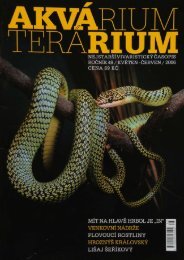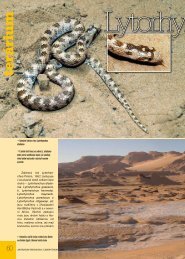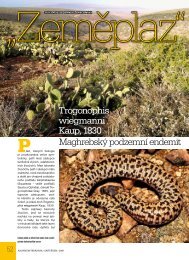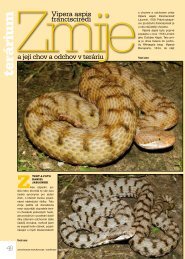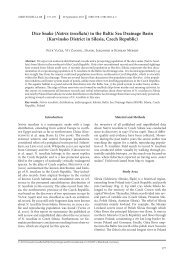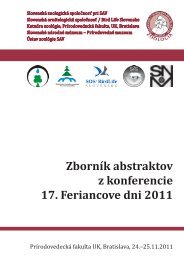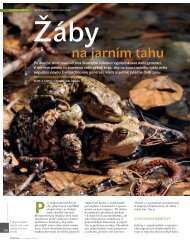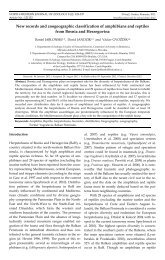Slow worm, Anguis fragilis (Reptilia: Anguidae ... - Daniel Jablonski
Slow worm, Anguis fragilis (Reptilia: Anguidae ... - Daniel Jablonski
Slow worm, Anguis fragilis (Reptilia: Anguidae ... - Daniel Jablonski
Create successful ePaper yourself
Turn your PDF publications into a flip-book with our unique Google optimized e-Paper software.
V. Gvoždík et al. / Molecular Phylogenetics and Evolution 55 (2010) 460–472 465<br />
assessed using 1000 bootstrap pseudoreplicates (Felsenstein,<br />
1985). MP and NJ analyses were performed with PAUP * 4.0b10<br />
(Swofford, 2003). The NJ analyses were executed twice: first time<br />
with uncorrected p-distances, and second time with distances<br />
based on the best model. The branch support was evaluated by<br />
bootstrap analysis (Felsenstein, 1985) with 10,000 pseudoreplicates.<br />
MP and NJ were employed also on the ND2-translated and<br />
PRLR-translated amino acid data sets. The settings were the same<br />
as for the DNA analyses, gaps were treated as a 21st amino acid<br />
in MP, and mean character difference was used as a distance measure<br />
in NJ. All distinct haplotypes were used in the amino acid<br />
analyses as well, and checked for synonymous and non-synonymous<br />
mutations.<br />
3. Results<br />
3.1. Mitochondrial DNA sequence diversity<br />
Among the 1425 base pair positions examined, 409 were variable,<br />
296 of which were parsimony informative. Several indels<br />
have occurred in all tRNA genes, except for tRNA-Ala and tRNA-<br />
Asn, and in the light-strand replication origin. One codon deletion<br />
in the ND2 gene was detected even in one ingroup clade (see below).<br />
For phylogenetic analyses, a data set of 39 distinct haplotypes,<br />
including outgroups, was used. Within the procedure of<br />
substitution-model selection, the BIC selected the TrN + I + G<br />
(Tamura and Nei, 1993) model, which was used in ML analysis. It<br />
identified the most likely tree with log likelihood (lnL)= 5696.45<br />
(Fig. 2). Model-averaged phylogeny (Posada and Buckley, 2004;<br />
Posada, 2008) showed exactly the same topology of the main<br />
clades as the most likely tree (not shown). Moreover, all main<br />
clades were supported by all most important models as weighted<br />
by the BIC suggesting that the different models support the same<br />
topology of the main lineages in our data set. All independent BI<br />
runs identified essentially identical topologies and likelihood estimates<br />
(mean lnL = 5428.80). MP analysis produced six mostparsimonious<br />
trees with a length of 747 steps (consistency index,<br />
CI = 0.656; retention index, RI = 0.869). All trees had identical<br />
topologies with respect to the main clades. Also both NJ trees, generated<br />
with uncorrected p-distances and the TrN + I + G (Tamura<br />
and Nei, 1993) distances, were consistent in their general topologies,<br />
and similar in the bootstrap support values.<br />
The ND2-translated amino acid data set consisted of 345 characters,<br />
78 were variable, of which 54 were parsimony informative.<br />
MP produced 357 most-parsimonious trees with a length of 137<br />
steps (CI = 0.715; RI = 0.889). All MP trees were congruent in the<br />
topologies of the main clades, although the bootstrap support for<br />
branching patterns was low, yielding a polytomy of most of the<br />
main clades in the bootstrap majority-rule consensus tree. A similar<br />
polytomy was obtained by the NJ algorithm after bootstrap<br />
analysis. The NJ tree with branch lengths is depicted in Fig. 3.<br />
In all mtDNA nucleotide analyses, A. cephallonica from Peloponnese<br />
was the sister lineage to a clade comprising all other lineages<br />
within the radiation (Fig. 2). However, deep divergences were<br />
<strong>Anguis</strong><br />
81/ */99<br />
0.87/*/*<br />
A. <strong>fragilis</strong><br />
sensu lato<br />
80/91/79<br />
0.91/0.99/*<br />
72/<br />
86/93<br />
0.88/<br />
0.98/*<br />
*** //<br />
*** //<br />
83/88/96<br />
0.97/ ** /<br />
ce1<br />
ce2<br />
*** //<br />
*** //<br />
*/*/*<br />
*/*/*<br />
*/*/99<br />
*/*/*<br />
99/98/99<br />
0.99/*/*<br />
*** //<br />
*** //<br />
g1<br />
g2<br />
g3<br />
g4<br />
g5<br />
g6<br />
g7<br />
g8<br />
g9<br />
g10<br />
g12<br />
g11<br />
g15<br />
g13<br />
g14<br />
g16<br />
c1<br />
c2 deletion 1bp<br />
c3<br />
c4<br />
c5<br />
c6<br />
c9<br />
c10<br />
c11<br />
c7<br />
c8<br />
f1<br />
f2<br />
f3<br />
f4<br />
f5<br />
f7<br />
f6<br />
clade C<br />
A. graeca<br />
Bedriaga, 1881<br />
clade B<br />
A. colchica<br />
(Nordmann, 1840)<br />
B1 - A. c. incerta Krynicki, 1837<br />
B2 - A. c. colchica<br />
B3 - A. c. orientalis Anderson, 1872<br />
clade A<br />
A. <strong>fragilis</strong><br />
Linnaeus, 1758<br />
A. cephallonica<br />
Werner, 1894<br />
*** //<br />
*** //<br />
Paa1<br />
Pat1<br />
Pseudopus apodus<br />
Hyalosaurus koellikeri<br />
0.01 substitution/site<br />
Fig. 2. Maximum likelihood haplotype tree showing the <strong>Anguis</strong> phylogeny as inferred from the ND2 and five tRNAs mtDNA sequences. Substitution model TrN + I + G with<br />
following values was used: substitution rate matrix AC = AT = CG = GT = 1.00, AG = 26.43, CT = 9.17; proportion of invariable sites P inv = 0.091; gamma shape rate variation<br />
among sites a = 0.201; base frequencies A = 0.33, C = 0.32, G = 0.13, T = 0.22. Numbers above branches indicate bootstrap support values for maximum likelihood/maximum<br />
parsimony/neighbor-joining analyses. Numbers below branches indicate the PhyML (Guindon and Gascuel, 2003) approximate likelihood-ratio test for branches values/<br />
Bayesian posterior probability values/uncertainty due to model selection. Asterisk indicates full support (100 or 1.00) for particular clade. Haplotype names as presented<br />
in Table 1.



